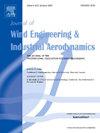Impact of inclined porous media hoods on micro-pressure waves induced by high-speed maglev trains traversing tunnels
IF 4.9
2区 工程技术
Q1 ENGINEERING, CIVIL
Journal of Wind Engineering and Industrial Aerodynamics
Pub Date : 2025-07-14
DOI:10.1016/j.jweia.2025.106175
引用次数: 0
Abstract
The high-speed maglev train traversing tunnels will cause noise pollution to the surrounding environment. Utilizing inclined porous media hoods (IPMHs) is an effective solution for mitigating micro-pressure waves (MPWs). This study employs an improved delayed detached eddy simulation turbulence model and overset technique to simulate the aerodynamic effects of maglev trains passing through tunnels. The reliability of the numerical method is validated through moving-model experimental data. The study investigates the influence of IPMH slope and location on wavefront characteristics and MPW evolution. The peak cut principle of the entrance IPMH and the exit pressure relief on the MPW amplitude are discussed. The research results indicate that the entrance IPMH achieves the effects of extending the wavefront rise time and achieving balance in the multi-peak wavefront gradient. The exit IPMH can regulate the balance between pressure relief amplitude and MPW amplitude by controlling its slope. IPMH causes the MPW profile to undergo three evolutionary stages: semi-frustum, semi-gourd shape, and semi-ellipsoid. Reducing the IPMH slope benefits increasing the solid radiation angle to facilitate pressure relief. The mitigation rates of MPW amplitude achieved by the entrance, exit, and side IPMHs are 52.2 %, 70.0 %, and 86.1 % respectively. The findings offer valuable references for the design of high-speed maglev tunnel hoods.
倾斜多孔介质罩对高速磁悬浮列车穿越隧道微压力波的影响
高速磁悬浮列车穿越隧道会对周围环境造成噪声污染。利用倾斜多孔介质罩(IPMHs)是缓解微压力波(mpw)的有效解决方案。本文采用改进的延迟分离涡模拟湍流模型和超调技术,模拟磁悬浮列车通过隧道时的气动效应。通过动模型实验数据验证了数值方法的可靠性。研究了IPMH坡面和位置对波前特征和波峰演化的影响。讨论了入口水势的截峰原理和出口泄压对水势幅值的影响。研究结果表明,入口IPMH达到了延长波前上升时间和实现多峰波前梯度平衡的效果。出口IPMH可以通过控制其坡度来调节泄压幅值与MPW幅值之间的平衡。IPMH使MPW剖面经历了半截锥体、半葫芦形和半椭球形三个演化阶段。减小IPMH斜率有利于增大固体辐射角,有利于泄压。入口、出口和侧面IPMHs对MPW振幅的抑制率分别为52.2%、70.0%和86.1%。研究结果为高速磁悬浮隧道通风柜的设计提供了有价值的参考。
本文章由计算机程序翻译,如有差异,请以英文原文为准。
求助全文
约1分钟内获得全文
求助全文
来源期刊
CiteScore
8.90
自引率
22.90%
发文量
306
审稿时长
4.4 months
期刊介绍:
The objective of the journal is to provide a means for the publication and interchange of information, on an international basis, on all those aspects of wind engineering that are included in the activities of the International Association for Wind Engineering http://www.iawe.org/. These are: social and economic impact of wind effects; wind characteristics and structure, local wind environments, wind loads and structural response, diffusion, pollutant dispersion and matter transport, wind effects on building heat loss and ventilation, wind effects on transport systems, aerodynamic aspects of wind energy generation, and codification of wind effects.
Papers on these subjects describing full-scale measurements, wind-tunnel simulation studies, computational or theoretical methods are published, as well as papers dealing with the development of techniques and apparatus for wind engineering experiments.

 求助内容:
求助内容: 应助结果提醒方式:
应助结果提醒方式:


